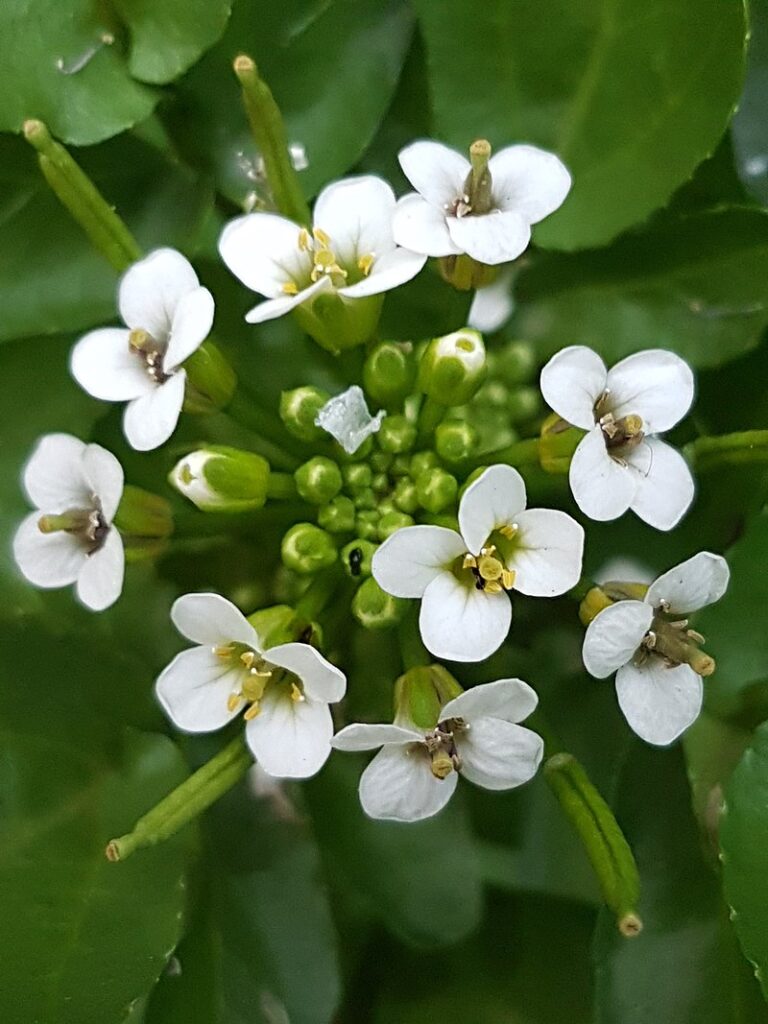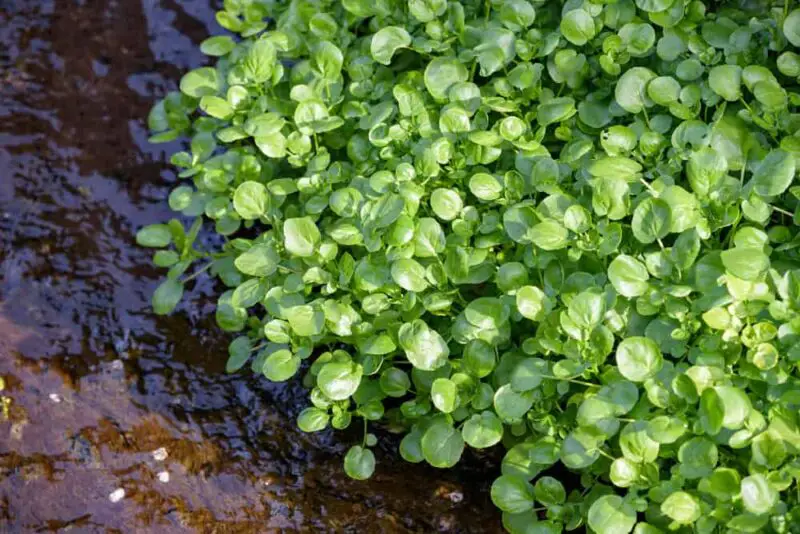Watercress (Nasturtium officinale) also known as yellow cress, is a fast-growing plant that grows in shallow water. With their green leaves and small white flowers growing in shallow streams, the wild plants stand out. And they grow almost everywhere now. They’re originally native to Europe and Asia, but they’re now in the United States and Canada as well.
But are these pretty plants edible?
Is Watercress Edible?
Yes, watercress is an edible plant. In fact, you can eat the whole plant. However, most people avoid the roots, since they don’t taste as great. This edible water plant is widely consumed around the world. Watercress is a leafy green. It is known for its peppery taste and is often used in salads, sandwiches, and soups.
Watercress is a member of the mustard family. Its relatives include other mustard greens like broccoli, arugula, collard greens, and kale. Watercress can be used in a lot of recipes where you might use spinach or kale. One exception is that watercress blends better than kale or spinach. So if you were going to make a smoothie, you would want to use the kale leaves and cut away the stems because kale stems get stringy in a blender and don’t work well or taste great. The entire watercress plant is fine to throw in a blender and make a smoothie with.
When selecting watercress, look for plants with vibrant green leaves and no signs of wilting or yellowing. When it begins to turn yellow, it’s not going to taste great anymore.
If you’ve collected wild watercress, make sure to store it in your fridge. To store watercress, rinse it thoroughly and place it in a container with water in the refrigerator. It will stay fresh longer if you change the water daily. It will keep for a few days, but it’s best eaten within 24 to 48 hours. The flavor is just better the sooner you eat it.

Does Watercress Give You Liver Fluke?
Liver fluke is a parasitic infection caused by fasciola hepatica. This infection happens when people eat raw watercress that’s been contaminated with immature parasite larvae. The larvae grow in the stomach and cause parasitic infections.
For this reason, it’s important to only harvest wild watercress that’s growing in clean water. It’s also important to wash watercress before eating it. Many people will feel comfortable identifying wild watercress, making sure the watercress is growing in clean water, washing it at home, and then eating raw watercress. Some people may prefer to take the extra step of cooking their watercress since this lowers the chance of something like liver fluke happening.
Eating unclean raw watercress also carries the risk of getting giardia (terrible stomach upset and possibly diarrhea).

Is Watercress A Superfood?
Yes, watercress has been called a superfood. These leafy greens are a good way to get a lot more vitamins and antioxidants into your diet, without adding a lot of carbs or fats.
Watercress plants are packed with nutrients. They are a rich source of vitamins and minerals, including vitamin C, A, K, and B6, calcium, magnesium, iron, and folate. It is also high in antioxidants, which help protect cells from damage caused by free radicals. The plant is low in calories and carbohydrates, making it an excellent choice for people who are trying to lose weight or manage their blood sugar levels. Since it has a strong spicy flavor, watercress can add a lot of peppery flavor to a salad without the need for fatty salad dressings. This encourages healthy eating habits.
Watercress is believed to have anti-inflammatory properties and may help reduce the risk of cancer and heart disease. Some studies have also suggested that watercress may help improve digestion and boost the immune system. In fact, in ancient times, the Persian King Xerxes compelled his soldiers to eat watercress during their long campaigns to keep them healthy. Also, in the 17th-century watercress soup became popular in Europe because it was claimed to cleans the blood.
Are Fool’s Watercress and True Watercress Different?
Fools watercress is a wild vegetable that grows in wet soil, often in shallow streams. It has green leaves, and white flowers is a perennial herb, and is safely edible. It’s easy to see why fool’s watercress and true watercress are often confused. If you were eating them though, you’d notice a difference. Fool’s watercress smells and tastes like carrots. True watercress has a smell all its own that is usually just described as the smell of watercress.
Note that fool’s watercress is easily confused with water parsnip, which is toxic. For this reason, it’s very important to use multiple sources to identify a plant before eating it. You may want to have some experience identifying fool’s watercress, true watercress, and water parsnip before consuming wild plants.
Where Do You Find Watercress?
Since watercress loves to grow in cold water, you might expect to find it in the shade. However, this plant loves rich soils in the full sun. Typically the plant is between four to ten inches tall. The edges of the leaves are more wavy than serrated. (Fool’s watercress has more serrated-looking leaves.)
You can find watercress growing year-round. However, in most of North America, it isn’t great to harvest it in the height of summer or winter. The heat steals some of the beloved flavor of watercress. The edible plant tastes more bitter when it’s hot outside. In the dead of winter, watercress plants tend to be smaller and harder to find and gather. While you might find a little, you’re not going to come away with a lot of watercress in January.
Early spring through late spring, or the middle of autumn, are great times to forage for watercress. At these times of the year, you’ll likely find watercress flowering.
A good way to collect watercress is to use scissors to cut the stems. You can also easily pull watercress up from the moist soil with your hands, but you’ll still need to cut off the roots later. While the roots are edible, people don’t usually enjoy the taste.
Watercress Is A Good Opportunity For More Advanced Foragers
A lot of people consider watercress to be a wild plant that only more advanced foragers should go looking for. While this semi-aquatic plant has many health benefits and isn’t always easy to find in a grocery store, there are also more precautions to take with watercress than you might need to take when foraging blackberries.
For example, watercress will often grow in unmanaged waterways. A careful forager will want to make sure they know they’re finding watercress in clean water, so some research on your local streams may be in order.
Watercress is also less familiar to many of us than something like carrots or blackberries, so foragers need to take a careful look at the leaves and take their time when comparing those leaves to lookalikes like water parsnip.
For outdoor enthusiasts growing their identification skills, watercress can be a great way to get good practice in. If you’re planning on eating the watercress, take the precautions of using multiple sources, know the water source for where the plant is growing, and wash the plant carefully before consuming.
Recent Posts
The only venomous snakes in Washington State are Northern Pacific Rattlesnakes. The Northern Pacific Rattlesnake (Crotalus oreganus oreganus) is a sub-species of the Western Rattlesnake. Anyone...
Skunks are not classified as true hibernators. But they go into a state of torpor when the weather gets cold. Skunks are light sleep hibernators, along with opossums, bears, and raccoons. ...
